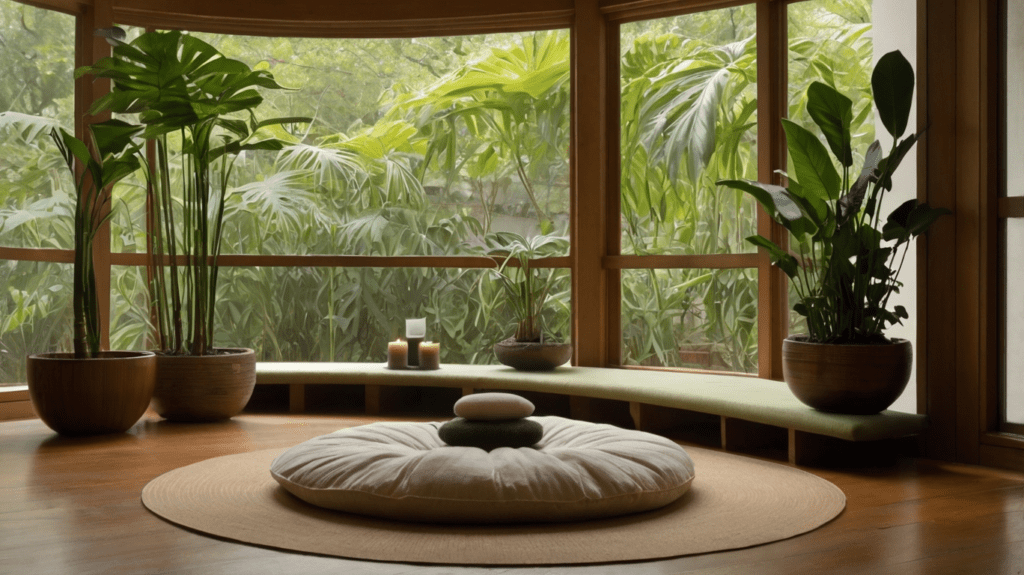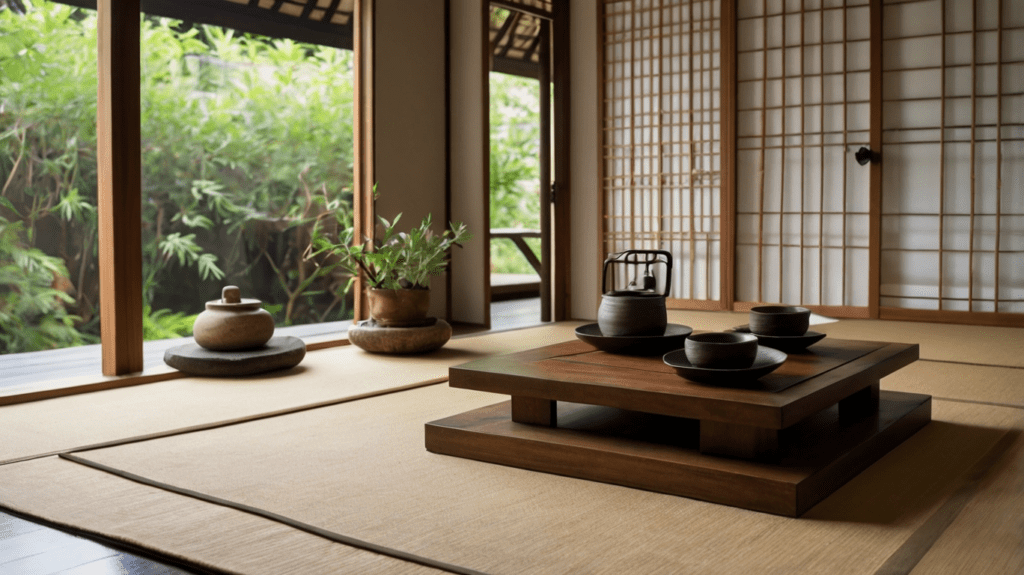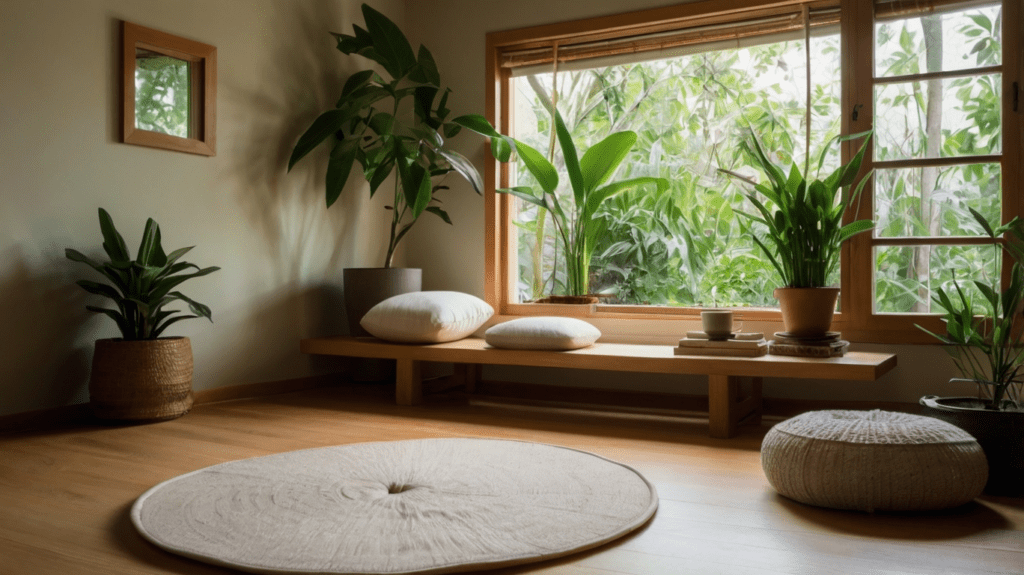As an interior designer, I’ve had the privilege of transforming countless spaces into havens of peace and tranquility.
Today, I’m excited to share my expertise on how to create a Zen meditation space right in your own home. Whether you’re a seasoned meditator or just beginning your mindfulness journey, having a dedicated space for reflection can be truly transformative.
Let’s dive into the art of crafting a personal sanctuary that nurtures your spirit and enhances your meditation practice.
Introduction: The Essence of Zen Meditation Spaces

Zen meditation, rooted in ancient Buddhist traditions, is all about achieving a state of focused attention and inner calm. The space where you meditate plays a crucial role in facilitating this practice. A well-designed Zen meditation space can help quiet the mind, reduce stress, and promote overall well-being.
In my years of designing spaces, I’ve seen firsthand how a thoughtfully created meditation area can become the heart of a home, offering a retreat from the chaos of daily life. It’s not just about aesthetics; it’s about creating an environment that supports your journey inward.
Choosing the Right Location for a Zen Meditation Space
The first step in creating your Zen meditation space is selecting the right location. This decision sets the foundation for your entire meditation experience.


Factors to consider:
- Quietness: Look for the quietest spot in your home, away from street noise and household bustle.
- Natural light: Soft, natural light can enhance the calming atmosphere. A space near a window is ideal, but ensure you can control the light with curtains or blinds.
- Size: You don’t need a large area. Even a 4×4 foot space can work wonders.
- Privacy: Choose a location where you won’t be frequently disturbed.
Unconventional spaces for meditation:
Don’t be afraid to think outside the box. Some of my most successful designs have involved transforming unexpected areas:
- Closet conversion: A spare closet can be emptied and transformed into a cozy meditation nook.
- Attic retreat: Attics offer a secluded space often bathed in soft, ambient light.
- Under-stairs sanctuary: That awkward space under the stairs can become a perfect meditation hideaway.
Personal anecdote: I once helped a client transform a neglected corner of her sunroom into a breathtaking meditation space. The natural light and view of her garden created an instant connection with nature, elevating her practice to new heights.
Can I create a Zen meditation space in a small apartment?
Absolutely! Size isn’t a barrier to creating a peaceful meditation area. Even a corner of your bedroom or living room can be transformed into a serene spot. The key is to define the space, perhaps with a room divider or a special rug, and keep it clutter-free.
Decluttering and Minimizing: Less is More
In the world of Zen design, simplicity reigns supreme. Decluttering is not just about creating physical space; it’s about clearing mental space as well.


The importance of a clutter-free environment:
- Reduces visual distractions
- Promotes a sense of calm and order
- Allows energy to flow freely in the space
Tips for minimalist decor:
- Remove unnecessary furniture and objects
- Choose multi-functional pieces when possible
- Opt for clean lines and simple shapes in furniture and decor
- Stick to a monochromatic or limited color palette
- Embrace negative space – not every wall needs adornment
Remember, minimalism doesn’t mean sterile. It’s about intentionality in your choices. Each item in your meditation space should serve a purpose or bring you joy.
Essential Elements of a Zen Meditation Space
Now that we’ve cleared the space, let’s focus on the essential elements that will transform it into a true Zen sanctuary.


1. Meditation cushions and seating options:
The right seating can make or break your meditation practice. Consider these options:
- Zafu cushions: Traditional round meditation cushions that elevate your hips and support proper posture.
- Meditation benches: Ideal for those who find floor sitting uncomfortable.
- Floor chairs: Offer back support for longer sessions.
- Yoga mats: Provide cushioning and define your meditation area.
2. Lighting:
Lighting sets the mood of your space. Aim for a soft, warm glow that’s gentle on the eyes.
- Natural light: Position your space near a window if possible, using sheer curtains to diffuse harsh sunlight.
- Himalayan salt lamps: Emit a soft, warm glow and are believed to purify the air.
- Dimmable LED lights: Allow you to adjust the brightness to suit your needs.
- Candles: Create a flickering, meditative ambiance (use with caution and never leave unattended).
3. Plants and natural elements:
Bringing nature indoors can significantly enhance the tranquility of your space.
- Low-maintenance plants like snake plants or ZZ plants
- Small indoor fountain for soothing water sounds
- Stones or crystals for grounding energy
- Driftwood or other natural wood elements
Personal touch: In one of my favorite projects, we created a living wall of air plants behind the meditation area. The client reported feeling more connected to nature and found her meditation deeper and more rejuvenating.
What’s the best flooring for a meditation space?
The best flooring is one that feels comfortable and grounding. Hardwood or bamboo floors with a soft rug work well. If you have carpet, ensure it’s low-pile for stability. Avoid slippery surfaces. The key is to create a stable, comfortable foundation for your practice.
Creating a Sensory-Friendly Environment
A truly immersive Zen meditation space engages all the senses, creating a cocoon of tranquility that envelops you the moment you enter.


1. Sound:
Silence is golden, but sometimes a bit of ambient sound can enhance your meditation.
- White noise machines: Mask disruptive external noises
- Water features: The gentle trickle of water induces relaxation
- Wind chimes: Soft, melodic tones can signal the start of your practice
- Singing bowls: Traditional tools for beginning and ending meditation sessions
2. Scent:
Our sense of smell is closely linked to memory and emotion. The right scent can instantly transport you to a calmer state.
- Incense: Traditional in many meditation practices, but use sparingly if you have sensitivities
- Essential oil diffusers: Try calming scents like lavender, sandalwood, or cedarwood
- Naturally fragrant woods: Cedar or sandalwood elements in your decor
3. Touch:
The textures in your space can greatly impact your comfort and focus.
- Soft, natural fabrics for cushions and throws (think organic cotton, linen, or bamboo)
- Smooth stones or mala beads for tactile focus during meditation
- Plush rugs to define your space and add comfort underfoot
Designer tip: Layer textures thoughtfully. A smooth wood floor, a softly textured rug, and a nubby cotton throw create a rich sensory experience without overwhelming the space.
Incorporating Zen Design Principles


Zen design is about more than just minimalism; it’s about creating harmony and balance in your space.
1. Color psychology for meditation spaces:
Colors can profoundly affect our mood and energy. For a Zen meditation space, consider:
- Whites and creams: For purity and clarity
- Soft greys: For stability and calm
- Muted blues and greens: For tranquility and connection to nature
- Earth tones: For grounding and warmth
Avoid bright or stimulating colors that might distract from your practice.
2. Balancing empty space and decorative elements:
In Zen design, empty space (or “ma” in Japanese) is as important as the objects within it. This balance creates a sense of spaciousness and possibility.
- Use the “rule of thirds” when arranging elements
- Allow for plenty of negative space on walls and surfaces
- Choose a few meaningful decorative items rather than many small ones
Remember, every item should earn its place in your meditation space.
DIY Zen Decor Projects
Adding personal touches through DIY projects can make your meditation space feel uniquely yours.


1. Creating your own Zen garden:
A miniature Zen garden can be a beautiful focal point and a tool for moving meditation.
Materials needed:
- A shallow tray
- Fine sand or gravel
- Small rocks or pebbles
- Miniature rake
Instructions:
- Fill the tray with sand or gravel
- Arrange rocks or pebbles mindfully
- Use the rake to create patterns in the sand
2. Upcycling furniture for meditation use:
Transform existing pieces into meditation-friendly furniture.
Ideas:
- Convert an old side table into a meditation altar
- Repurpose a vintage suitcase as a portable meditation kit
- Turn a ladder into a multi-level plant stand
Personal anecdote: One of my clients, an avid traveler, used souvenirs from her journeys to create a stunning meditation altar. Each item held a special memory, making her space deeply personal and meaningful.
How often should I change or update my meditation space?
While consistency can be beneficial for establishing a routine, periodic refreshes can reinvigorate your practice. Consider making small seasonal changes, like switching out textiles or adding elements that reflect the current season. A major redesign every year or two can help your space evolve with your practice.
Tech-Free vs. Tech-Integrated Meditation Spaces
In our digital age, the question of whether to include technology in your meditation space is an important one.


Pros of a tech-free space:
- Minimizes distractions
- Encourages disconnection from digital stress
- Aligns with traditional meditation practices
Cons of a tech-free space:
- Limits access to guided meditations and timer apps
- It may be challenging for beginners who rely on guidance
Incorporating meditation apps and devices without disrupting the Zen atmosphere:
If you choose to include tech, do so mindfully:
- Use devices with minimal design and muted colors
- Hide cords and chargers to maintain a clean look
- Consider a dedicated tablet or e-reader for meditation apps
- Invest in high-quality, discreet speakers for guided meditations or ambient sounds
Designer tip: Create a hidden charging station within a decorative box or behind a room divider to keep technology out of sight when not in use.
Adapting Your Meditation Space for Different Practices
A versatile meditation space can accommodate various mindfulness practices, enhancing its usefulness and your spiritual journey.


Yoga-friendly layouts:
- Ensure enough floor space for a yoga mat
- Install a wall-mounted or freestanding mirror for checking alignment
- Consider adding props like blocks, straps, and bolsters
- Opt for flooring that provides good traction, like cork or textured vinyl
Accommodating group meditation sessions:
- Use stackable floor cushions for easy storage
- Incorporate modular furniture that can be easily moved
- Consider a larger, central focal point like a statue or art piece
- Plan for adequate ventilation, especially for larger groups
Maintaining Your Zen Space
A serene meditation space requires regular maintenance to retain its calming energy.


Regular cleaning routines:
- Daily: Light dusting, straightening cushions, and removing any clutter
- Weekly: Vacuuming or sweeping, wiping down surfaces
- Monthly: Deep cleaning of textiles, washing windows, and refreshing plants
Seasonal refreshes and updates:
- Spring: Introduce fresh, bright elements and deep clean
- Summer: Lighten fabrics and add cooling elements like fans
- Fall: Incorporate warmer colors and cozy textures
- Winter: Add extra warmth with throws and consider a sun lamp for darker days
Zen Meditation Spaces for Small Living Areas


Limited space doesn’t mean limiting your meditation practice. Here are some solutions for compact living:
Portable meditation kits:
Create a kit that can be easily set up and stored away:
- Foldable meditation cushion
- Travel-sized singing bowl
- Compact essential oil diffuser
- Roll-up mat to define your space
Multi-functional furniture ideas:
- Ottoman with storage for meditation supplies
- Wall-mounted drop-leaf table as a meditation altar
- A room divider that doubles as a storage unit
- Floor pillows that can be used for seating and meditation
Creating a Budget-Friendly Zen Space


Cultivating inner peace doesn’t have to break the bank. Here are some cost-effective strategies:
Thrifting and upcycling tips:
- Scout thrift stores for unique containers, textiles, and decorative items
- Repurpose items you already own – a serving tray can become a Zen garden base
- Join local buy-nothing groups for free items
Low-cost alternatives to expensive Zen decor:
- Use river rocks instead of purchased meditation stones
- Create your own wall art with calligraphy or nature photography
- Make your own meditation cushion covers from affordable fabrics
- Use battery-operated LED candles instead of specialty meditation lamps
Personalizing Your Meditation Space
While Zen aesthetics favor simplicity, your meditation space should still reflect your personal journey.


Incorporating meaningful objects and artwork:
- Display a small statue or image that resonates with your spiritual path
- Include a journal or meaningful book on mindfulness
- Add a personal mantra or inspiring quote in beautiful calligraphy
Balancing personal touches with minimalism:
- Choose one statement piece as a focal point
- Rotate personal items seasonally to maintain a clutter-free space
- Use a cohesive color scheme to tie personal elements together
Personal story: I once worked with a client who was a potter. We incorporated one of her handmade bowls as a centerpiece in her meditation space. It served as both a beautiful focal point and a reminder of her creative practice, which she saw as a form of meditation.
How can I create a meditation space that works for multiple family members?
Creating a shared meditation space requires open communication and compromise. Consider using neutral colors and decor that appeal to everyone. Incorporate adjustable elements like stackable cushions and versatile lighting.
Create a system for personalizing the space during individual use, perhaps with meaningful objects that can be easily added and removed. The key is to maintain the core elements of a Zen space while allowing for personal expression.
Conclusion: Your Journey to Inner Peace Begins at Home
Creating a Zen meditation space in your home is more than just an interior design project – it’s a profound act of self-care and spiritual growth. By thoughtfully curating an environment that speaks to tranquility and mindfulness, you’re setting the stage for transformative experiences right in the comfort of your own home.
Remember, your meditation space will evolve as you do. Don’t be afraid to make changes as your practice deepens and your needs shift. The most important element is your commitment to showing up and using the space regularly.
As you embark on this journey of creating your personal Zen oasis, keep in mind that perfection is not the goal. Your space should feel welcoming and authentic to you. Trust your intuition, and let your meditation space be a reflection of your inner calm.
Now, take a deep breath, and take the first step towards creating your very own sanctuary of peace. Your future self will thank you for this gift of tranquility amidst the hustle and bustle of daily life.
Namaste.



